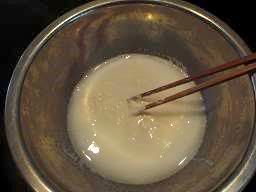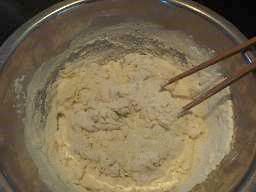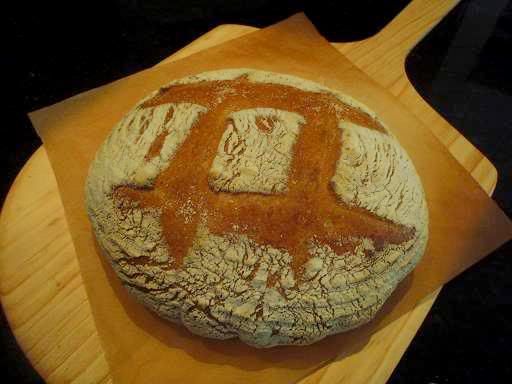I wanted to see if James MacGuire's Pain de Tradition procedure would improve my San Francisco Sourdough. My formula is as follows:
220 g San Francisco starter @75% hydration (ie, 126 g white bread flour and 94 g water)
374 g white bread flour
306 g water
10 g salt
2 g instant dry yeast
(ie, total flour is 500 g and total water is 400 g)



(left) SF starter with some water to loosen it up first
(center) mix in all remaining recipe water
(right) combine all ingredients
After which I followed James MacGuire's pain de tradition procedure as in [url=http://www.thefreshloaf.com/node/12866/james-j-macguire039s-pain-de-traditionJ/][b]my earlier post[/b][/url]. And, here is what I've got:

[color=brown]San Francisco Sourdough Bread using James MacGuire's pain de tradition procedure[/color]

[color=brown]The crumb[/color]
I went a bit heavy handed, dusting too much flour on the banneton before I put the shaped dough in. James specifically advises against it because too much flour will hinder browning and crispness. Other than that, I am very pleased with the result. Essentially this is the same as the white Pain de Tradition with an extra depth in flavor - due to the San Francisco sourdough starter. With the help of a little yeast, the crumb opens up so well.
Not sure if I can call this boule a genuine sourdough, but, the heavily floured crust notwithstanding, it is a great bread that my family enjoyed. My husband said to me, "I don't think that I've ever had bread that good; it's the simplicity of the flavor ...." He said, "I don't know if I'll mature into rye and other grains but ... the intensive flavor of this one is just [b]bloody[/b] sensational!" Sometimes I'm not sure if I would ever be accustomed to Aussie lingo.
Shiao-Ping
- Shiao-Ping's Blog
- Log in or register to post comments
Your pictures look just like Sylvia's bread! Nice open crumb.
--Pamela
Hi, Shiao-Ping.
All of the pains de traditions are just gorgeous!
I was intending to make it this weekend with sourdough starter, and you've done the experiment for me. :-)
How did you do the folding of the dough? "Slap and fold?" Bertinet method? Fold in the bowl?
David
Hi David, I have gone back to my original post [url=http://www.thefreshloaf.com/node/12866/james-j-macguire039s-pain-de-tradition/][b]here[/b][/url] and added a new section under the heading [b][u]Folding technique[/u][/b], which is just before [u][b]Fermentation schedule[/b][/u]. I had been feeling uncomfortable that I did not explain his technique fully. At the time I was conscious that my post was already a very lengthy one and I didn't want to burden people with so many details. But as I thought about it more the last couple of days, folding is really very important to his whole procedure, and I thought it's best that I do it in the post.
So, to answer your question, it is a "fold in the bowl" thing. It's a wonder how a simple technique like that makes the dough strong and does the job for what we want in artisan breads.
Please click on the link above and read the [u][b]Folding technique[/b][/u] section if you want more information.
Thanks for your question.
Shiao-Ping
Thanks!
This is the technique I've been using for many breads. The difference is that I have been doing more folds (20-30) at closer intervals (20-30 min.) fewer times (3-4). I'm looking forward to trying McGuire's way.
David
Shiao-Ping,
All of your breads looked great!
I had seen the James MacGuire article in the Art of Eating but never got around to trying his recipe. Thanks for being the pioneer. Maybe I will try to make some Levain baguettes based on his method this weekend.
For you sourdough bread, did you reduce the amount of instant yeast since you have a sourdough starter?
Don
... (my ingredient list for this sourdough bread shows 2g instant dry yeast). I intended for the San Francisco starter to be there for flavor only.
So, you read The Art of Eating magazine? I believe that qualifies you as a gourmet. The winter 2006 issue is my first (and only) issue.
Thanks very much for your comment.
Shiao-Ping
I have been a fan of Ed Behr and his Art of Eating magazine for years. I highly recommend issue 60 (winter 2002) which lists all the addresses for the best food destinations in Paris. My wife and I made a trip in 2006 to check out most of those places. It was fabulous and that is how we discovered the baguette a l'ancienne from Philippe Gosselin.
Don
Thank you, Don. Last week I ordered a copy of Edward Behr's book, The Artful Eater. The New York Times Book Review says his "territory is his own taste, his own mind" and that the book "express(es) the erudite thoughts of a sensualist ..." It reads so alluring to me, and at the same time, I am mindful that one person's gourmet food may not be another's gourmet food (it's like the saying beauty is in the eyes of a beholder!).
Are there any more issues that you would recommend?
Thanks again,
Shiao-Ping
Another gorgeous bake, Shiao-Ping!
This just keeps getting better! Your husband gives a wonderful discription of this bread and I would also say it fits the one I tried!
Sylvia
Very nice. Great crumb. Dave
In the last stage of stretch and folds, you say to sift flour down the edges to then roll it out to a work surface. I take it you do this after, the last set of folds?
I'm thinking that I should be able to tighten the round on the counter, then place it in the basket after the resting time.
I'm very surprised at how manageable the 80% hydration dough is. The folding and fermenting really strengthens the gluten.
Eric
... for us to turn out the dough onto a floured surface for final shaping.
I am quite surprised myslef at how manageable the 80% hydration dough is. The folding is the trick. We could say that the folding lasts almost the whole duration of the dough - from the time it's mixed to the time before it's gone into the oven! And, to think there is no kneading to achieve this! Isn't that something!
Shiao-Ping
All your breads are beautiful. I made two batches of your original recipe today as baguettes but put them in the fridge to bake tomorrow morning. I hope it works. If not, next time I'll do it in one day as written.
Thanks for all the inspiration. I'm waiting to hear your answers to David, Don and Eric's questions as I was wondering the same thing.
weavershouse
Hi, Shiao-Ping.
Since you like these James MacGuire breads so much, you should be aware that there is another of his formulas in Hamelman's "Bread." It is for his "Miche, Pointe-à-Callière."
This is a sourdough high-hydration Miche made with high extraction flour, and it is sensational. In my opinion, it is superior to Pain Poilâne - all of the attempts to reproduce it in the various bread books and the original. I know this may be heretical, but that's my opinion.
I've always made the Miche, Pointe-à-Callière following Hamelman's instructions for mixing.
This link has several TFL bakers' examples of this bread, FYI.
David
It will be on my top priority list to try.
Execuse me for my ignorance but where is the Pain Poilane that you are referring to?
Shiao-Ping
Hi, Siao-Ping.
The formula's to which I referred are Reinhart's in BBA and Leader's in "Local Breads." I have also had the original in Paris.
David
Shiao-Ping
I don't recall who it was that first posted the "fold in a bowl" technique here. I really should try to find the first reference to it, it's such a fabulous method. I have been doing it using the plastic dough scraper and instead of grabbing the dough with my hands, I scoop under it and will then sometimes hold down the edge with a thumb as I pull it upward. As you say, it is remarkable how strong the dough becomes with such a simple method.
I have another batch fermenting now. This time using 220g of starter and only 1/4 teaspoon of IDY. The ferment might be slightly longer but that's OK. I also swapped 25g of rye in. I'm guessing this dough will be a little more loose at the end due to the addition of the SD culture. I didn't make any other changes to the water for the rye.
Eric
Hi, Eric.
I believe Pat (proth5) was the first to write about this technique on TFL. I learned it from her and first used in myself August 9, 2008.
David
Hi Eric,
I had enjoyed the idea of mixing gently with my fingertips instead of my dough wisk...but also used the plastic dough scraper for the folding...I loved the chopsticks that were used for mixing.
Sylvia
... using the plastic scraper instead of my hand, but I've found that it is harder to fold ALL of the part of dough on the side to be folded - it's like the scraper is only scraping the surface of the part of the dough. So, for me, it's the hand folding.
The way you described your way of using the scraper sounds to me as if the scraper is a guide because you also use your thumb to help holding the edge of the dough as it is folded down. This sounds to me in actual fact both hand and scraper are at work. Right?
Shiao-Ping
I have the scraper grasped with my four fingers and my thumb and all the palm following behind my thumb lays over the top onto the edge of the dough...so it's does envolve for me both hand,scraper and forearm movement...if that makes since? I think for me... the scraper just replaces the four fingers.
Sylvia
Shiao-Ping,
I haven't tried to fold totally by hand in a bowl. I do have good luck using my thumb to lock the part of the dough I am stretching. And, I keep my hands clean for the most part. I think what we are doing in the bowl is a blend of folding and kneading. Folding is much less dynamic on the dough. This is more like kneading with a scraper I think.
For larger batches I use a food tub and fold by hand in the tub, letter style.